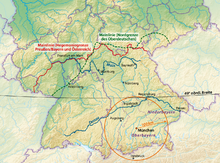Weißwurstäquator
Supposed cultural boundary between South and North Germany
You can help expand this article with text translated from the corresponding article in German. (January 2022) Click [show] for important translation instructions.
- View a machine-translated version of the German article.
- Machine translation, like DeepL or Google Translate, is a useful starting point for translations, but translators must revise errors as necessary and confirm that the translation is accurate, rather than simply copy-pasting machine-translated text into the English Wikipedia.
- Consider adding a topic to this template: there are already 9,120 articles in the main category, and specifying
|topic=will aid in categorization. - Do not translate text that appears unreliable or low-quality. If possible, verify the text with references provided in the foreign-language article.
- You must provide copyright attribution in the edit summary accompanying your translation by providing an interlanguage link to the source of your translation. A model attribution edit summary is
Content in this edit is translated from the existing German Wikipedia article at [[:de:Weißwurstäquator]]; see its history for attribution. - You may also add the template
{{Translated|de|Weißwurstäquator}}to the talk page. - For more guidance, see Wikipedia:Translation.


"Weißwurstäquator" (German pronunciation: [ˈvaɪsvʊʁst.ɛˌkvaːtoːɐ̯] ⓘ; lit. 'white sausage equator') is a humorous term describing the supposed cultural boundary separating Southern Germany from the northern parts, especially Bavaria from Central Germany.[1]
It is named for the Weisswurst sausage of Bavaria, and has no precise definition. A popular one is the linguistic boundary known as the Speyer line separating Upper German from Central German dialects, roughly following the Main River; another is a line running further south, more or less along the Danube, or between the Main and the Danube, roughly along the 49th parallel north circle of latitude.[2]
See also
- Röstigraben
- Barassi Line
References
- Duden Deutsches Universalwörterbuch, 6th edition, ISBN 3-411-05506-5 (in German)
External links
- definition on Indigo Magazine, p.57
- Interview with Oktoberfest innkeeper Wiggerl Hagn at Deutschlandradio Kultur (in German)
- v
- t
- e










